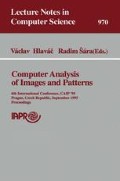Abstract
The paper describes a method for generating a generic deformable model from a training set of shapes depicted in a corpus of image sequences. Individual shapes in the training set are extracted automatically from the image sequences and represented by the control points of a B-spline surface. The generic model is derived by principal component analysis on the aligned training shapes. Using the acquired generic models, 3-D shape recovery, tracking and object identification are implemented within one procedure. Experimental results are presented both for generation and application of the model within the domain of vehicles appearing in traffic scenes.
Preview
Unable to display preview. Download preview PDF.
References
X. Shen and D. Hogg. 3-D Shape Recovery Using A Deformable Model. Image and Vision Computing Journal, 1995. to appear.
D. Terzopoulos, A. Witkin, and M. Kass. Constraints on Deformable Models: Recovering 3D Shape and Nonrigid Motion. Artificial Intelligence, 36(1):91–123, 1988.
A. Pentland and S. Sclaroff. Closed-form Solution for Physically Based Shape Modelling and Recognition. IEEE Transactions on Pattern Analysis and Machine Intelligence, PAMI-13(7):715–729, July 1991.
D. Terzopoulos and D. Metaxas. Tracking Nonrigid 3D Objects. In A. Blake and A. Yuille, editors, Active Vision, pages 75–89. MIT Press, 1992.
T. F. Cootes, C. J. Taylor, D. H. Cooper, and J. Graham. Training Models of Shape from Sets of Examples. In David Hogg and Roger Boyle, editors, British Machine Vision Conference 1992, pages 9–18, Leeds, UK, September 1992. Springer-Verlag.
A. Baumberg and D. Hogg. Learning Flexible Models from Image Sequences. In Jan-Olof Eklundh, editor, Computer Vision — ECCV'94, volume I, pages 299–308. Springer-Verlag, 1994.
X. Shen and D. Hogg. Generic 3-D Shape Model: Acquisitions and Applications. Technical Report 95.4, School of Computer Studies, The University of Leeds, Leeds, LS2 9JT, UK, February 1995.
I. T. Jolliffe. Principle Components Analysis. Springer-Verlag, 1986.
L. E. Scales. Introduction to Non-linear Optimization. Macmillan, 1985.
Author information
Authors and Affiliations
Editor information
Rights and permissions
Copyright information
© 1995 Springer-Verlag Berlin Heidelberg
About this paper
Cite this paper
Shen, X., Hogg, D. (1995). Generic 3-D shape model: Acquisitions and applications. In: Hlaváč, V., Šára, R. (eds) Computer Analysis of Images and Patterns. CAIP 1995. Lecture Notes in Computer Science, vol 970. Springer, Berlin, Heidelberg. https://doi.org/10.1007/3-540-60268-2_285
Download citation
DOI: https://doi.org/10.1007/3-540-60268-2_285
Published:
Publisher Name: Springer, Berlin, Heidelberg
Print ISBN: 978-3-540-60268-2
Online ISBN: 978-3-540-44781-8
eBook Packages: Springer Book Archive

